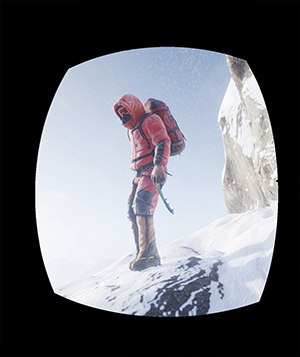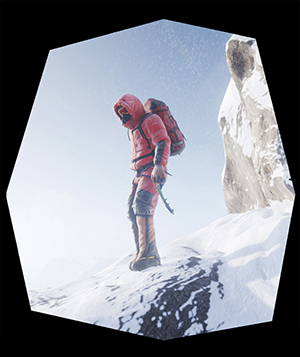With the Pascal architecture inside GeForce GTX 10-Series GPUs and laptops, developers can leverage new technologies and techniques to accelerate performance and enhance graphical fidelity. In Virtual Reality, our VRWorks suite of technologies lead the way, giving VR users a more responsive experience, and improved graphics that increase the player's sense of presence.
One of the many titles already benefitting from VRWorks is Sólfar Studios' Everest VR, a game in which you scale a photorealistic recreation of Mount Everest. Earlier this year, the stunning game added NVIDIA VRWorks’ Multi-Res Shading, a technology that warped the image and decreased the resolution of the image in your peripheral sight, where you don’t notice the changes, increasing performance by up to 65%.
In other words, Multi-Res Shading gave mid-range GPUs the performance of high-end GPUs, and high-end GPUs the performance of cards that don't yet exist. And with all that extra performance image quality and immersion could be greatly improved through the addition of NVIDIA Turbulence snow particles, and higher levels of Supersampling.
Today, Everest VR has added a new Pascal-exclusive VRWorks technology called Lens Matched Shading, which delivers even great performance gains than the Maxwell and Pascal-exclusive Multi-Res Shading. Simply put, Lens Matched Shading uses the Simultaneous Multi-Projection elements of the Pascal architecture to reduce the number of pixels that have to be rendered, giving you an excellent increase in performance without the reduction of peripheral fidelity that Multi-Res Shading relies upon.
Without Lens Matched Shading, a VR headset renders a rectangle and then squeezes it to the dimensions of the display and lens.
|
|
This process renders 86% more pixels than necessary, and it is this performance-sapping wastefulness that Lens Matched Shading fixes. To achieve this, Pascal’s Simultaneous Multi-Projection technology divides the original rectangle output into four quadrants, and adjusts them to the approximate shape of the final image.
In technical terms, the final image shown in the headset is 1.1 Megapixels per eye, the first-pass image without Lens Matched Shading is 2.1 Megapixels per eye, and with Lens Matched Shading is just 1.4 Megapixels per eye. That's a 50% increase in throughput available for pixel shading, which translates into a 15% performance improvement over Multi-Res Shading, without any reduction in peripheral image quality.
With the extra performance provided by Lens Matched Shading entry-level users can enjoy faster, more responsive gameplay with less use of Reprojection, and with fewer dropped frames. And mid-to-high end players can crank up visual effects and Supersampling for an even more immersive experience.
To try Lens Matched Shading for yourself, download Sólfar Studios' Everest VR from Steam today. And for news of Lens Matched Shading's integration into other Virtual Reality games stay tuned to GeForce.com.


